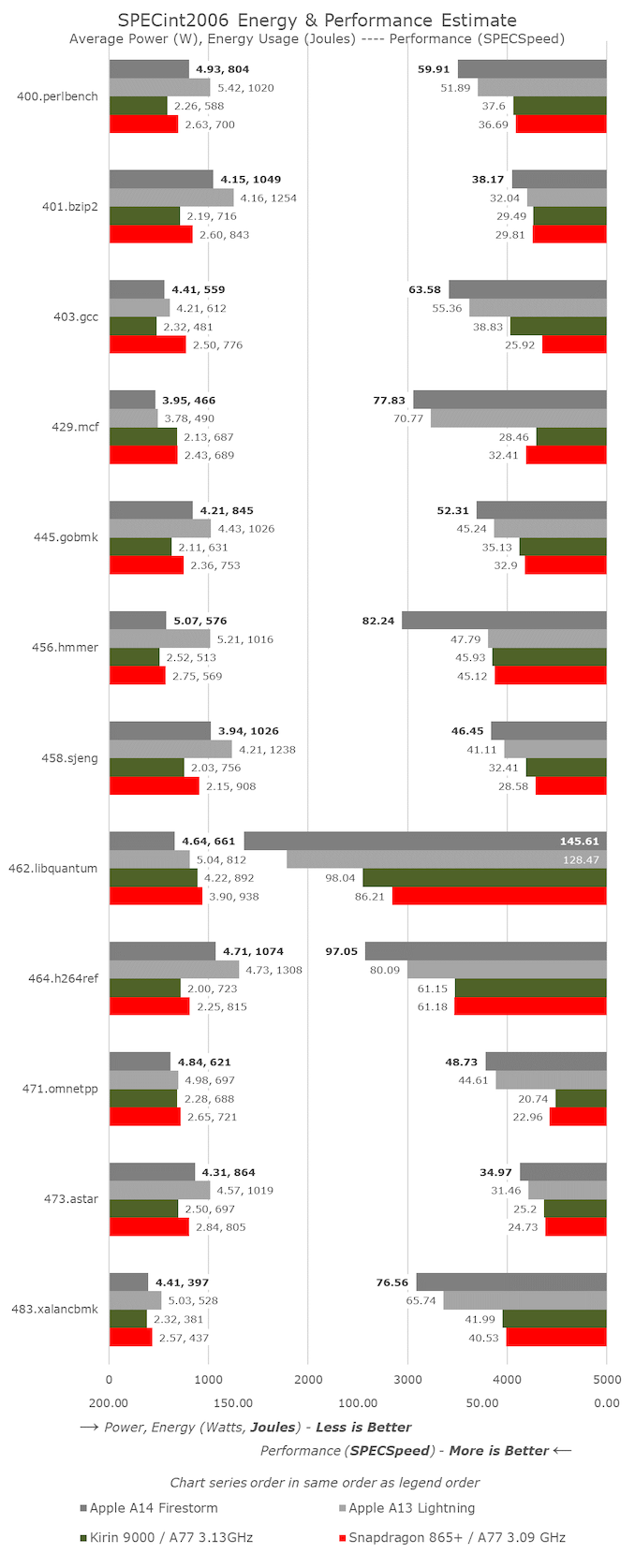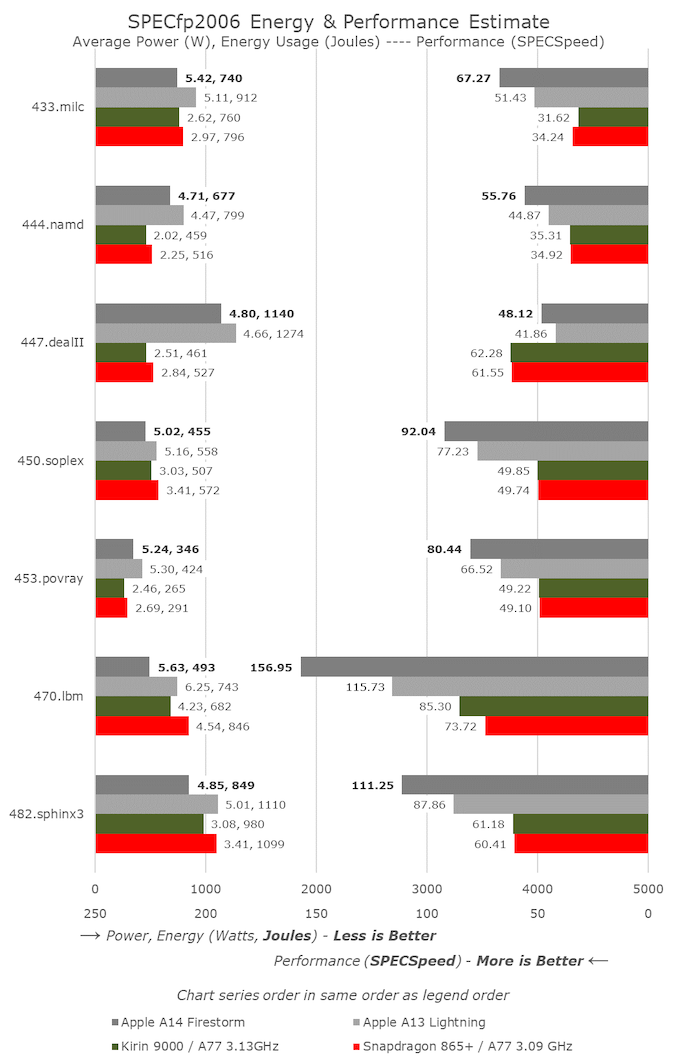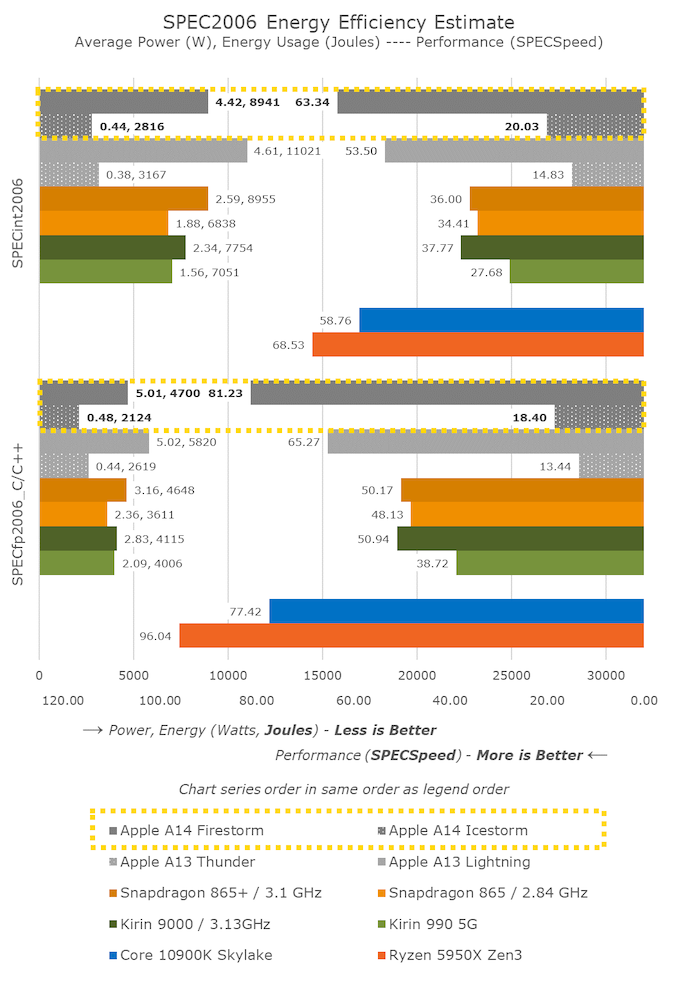Apple Announces The Apple Silicon M1: Ditching x86 - What to Expect, Based on A14
by Andrei Frumusanu on November 10, 2020 3:00 PM EST- Posted in
- Apple
- Apple A14
- Apple Silicon
- Apple M1
Dominating Mobile Performance
Before we dig deeper into the x86 vs Apple Silicon debate, it would be useful to look into more detail how the A14 Firestorm cores have improved upon the A13 Lightning cores, as well as detail the power and power efficiency improvements of the new chip’s 5nm process node.
The process node is actually quite the wildcard in the comparisons here as the A14 is the first 5nm chipset on the market, closely followed by Huawei’s Kirin 9000 in the Mate 40 series. We happen to have both devices and chips in house for testing, and contrasting the Kirin 9000 (Cortex-A77 3.13GHz on N5) vs the Snapdragon 865+ (Cortex-A77 3.09GHz on N7P) we can somewhat deduct how much of an impact the process node has in terms of power and efficiency, translating those improvements to the A13 vs A14 comparison.
Starting off with SPECint2006, we don’t see anything very unusual about the A14 scores, save the great improvement in 456.hmmer. Actually, this wasn’t due to a microarchitectural jump, but rather due to new optimisations on the part of the new LLVM version in Xcode 12. It seems here that the compiler has employed a similar loop optimisation as found on GCC8 onwards. The A13 score actually had improved from 47.79 to 64.87, but I hadn’t run new numbers on the whole suite yet.
For the rest of the workloads, the A14 generally looks like a relatively linear progression from the A13 in terms of progression, accounting for the clock frequency increase from 2.66GHz to 3GHz. The overall IPC gains for the suite look to be around 5% which is a bit less than Apple’s prior generations, though with a larger than usual clock speed increase.
Power consumption for the new chip is actually in line, and sometimes even better than the A13, which means that workload energy efficiency this generation has seen a noticeable improvement even at the peak performance point.
Performance against the contemporary Android and Cortex-core powered SoCs looks to be quite lopsided in favour of Apple. The one thing that stands out the most are the memory-intensive, sparse memory characterised workloads such as 429.mcf and 471.omnetpp where the Apple design features well over twice the performance, even though all the chip is running similar mobile-grade LPDDR4X/LPDDR5 memory. In our microarchitectural investigations we’ve seen signs of “memory magic” on Apple’s designs, where we might believe they’re using some sort of pointer-chase prefetching mechanism.
In SPECfp, the increases of the A14 over the A13 are a little higher than the linear clock frequency increase, as we’re measuring an overall 10-11% IPC uplift here. This isn’t too surprising given the additional fourth FP/SIMD pipeline of the design, whereas the integer side of the core has remained relatively unchanged compared to the A13.
In the overall mobile comparison, we can see that the new A14 has made robust progress in terms of increasing performance over the A13. Compared to the competition, Apple is well ahead of the pack – we’ll have to wait for next year’s Cortex-X1 devices to see the gap narrow again.
What’s also very important to note here is that Apple has achieved this all whilst remaining flat, or even lowering the power consumption of the new chip, notably reducing energy consumption for the same workloads.
Looking at the Kirin 9000 vs the Snapdragon 865+, we’re seeing a 10% reduction in power at relatively similar performance. Both chips use the same CPU IP, only differing in their process node and implementations. It seems Apple’s A14 here has been able to achieve better figures than just the process node improvement, which is expected given that it’s a new microarchitecture design as well.
One further note is the data of the A14’s small efficiency cores. This generation we saw a large microarchitectural boost on the part of these new cores which are now seeing 35% better performance versus last year’s A13 efficiency cores – all while further reducing energy consumption. I don’t know how the small cores will come into play on Apple’s “Apple Silicon” Mac designs, but they’re certainly still very performant and extremely efficient compared to other current contemporary Arm designs.
Lastly, there’s the x86 vs Apple performance comparison. Usually for iPhone reviews I comment on this in this section of the article, but given today’s context and the goals Apple has made for Apple Silicon, let’s investigate that into a whole dedicated section…













644 Comments
View All Comments
dotjaz - Wednesday, November 11, 2020 - link
They are probably referring to BootCamp.daveedvdv - Thursday, November 12, 2020 - link
Apple has confirmed that Apple Silicon Macs won't support BootCamp anymore.No, they were definitely talking about Rosetta 2. That said, I don't think they said it was a common occurrence. Just that it had been observed on a real application. At least, that's my recollection.
guycoder - Wednesday, November 11, 2020 - link
I suspect a lot of the graphics privatives are translated to running native and are getting an uplift from the new GPU. Sure this is a fast SOC but Rosetta is also converting large parts of any X86 application to the corresponding Apple ARM system library and taking advantage of the extra hardware on the M1. Still all very impressive so far and it's going to be fun to see what having the CPU / GPU / NPU so tightly integrated will bring.valuearb - Tuesday, November 10, 2020 - link
It's running MacOS, which isn't based on iOS. Actually WatchOS is based on iOS is based on MacOS which is based on NextStepOS.Benchmarks have already shown emulated Intel code is running roughly as fast on Apple Silicon as it runs on Intel Macs. These benchmarks came from Developers using the DTK, the ARM based Mac mini Apple gave developers to develop on earlier this year, and it was running a year old iPad processor.!
And PowerPC wasn't better than Intel, especially at the end.
Luminar - Wednesday, November 11, 2020 - link
PowerPC had the advantage of 3DNow! InstructionsZoolook - Wednesday, November 11, 2020 - link
3DNow! was AMD's answer to MMX, was later dropped (mostly) when they licensed SSE.Zoolook - Wednesday, November 11, 2020 - link
Wish we had an edit function, @Luminar maybe you are thinking about Altivec which was the PowerPC SIMD functions, it was indeed poweerful when it was introduced.Ppietra - Wednesday, November 11, 2020 - link
moving the code shouldn’t take that long for many apps. for many it will only need recompile and debugging.Cubesis - Wednesday, November 11, 2020 - link
Um PowerPC was not better than intel... it was way more power hungry. That’s why they switched to Intel in the first place. Even if moving the code did take a long time, (it won’t) Rosetta 2 improvements combined with them being faster than Intel chips, Means that although I can’t wait for everything to be optimized, I don’t really care when everything performs about the same emulated with Rosetta 2 sometimes even outperforming native intel binaries.Cubesis - Wednesday, November 11, 2020 - link
By the way although I understand where you were going with you were admittedly justified criticisms of Big Sur, your Intel MacBook Pro will be running that same operating system. Unless you plan on letting the system go obsolete with an OS that will be left behind. Fun fact. iOS technologically was derived from MacOS X so to say it’s being done the other way around makes no sense. MacOS can’t be a copy of iOS when iOS is already a copy of MacOS. If your Criticisms are solely about interface changes and methodology then I couldn’t agree with you more and hope it’s at least part of their secret long term plan to incorporate touch into macOS. That would be the only smart reason to make it shittier to navigate using keyboard and mouse LoL